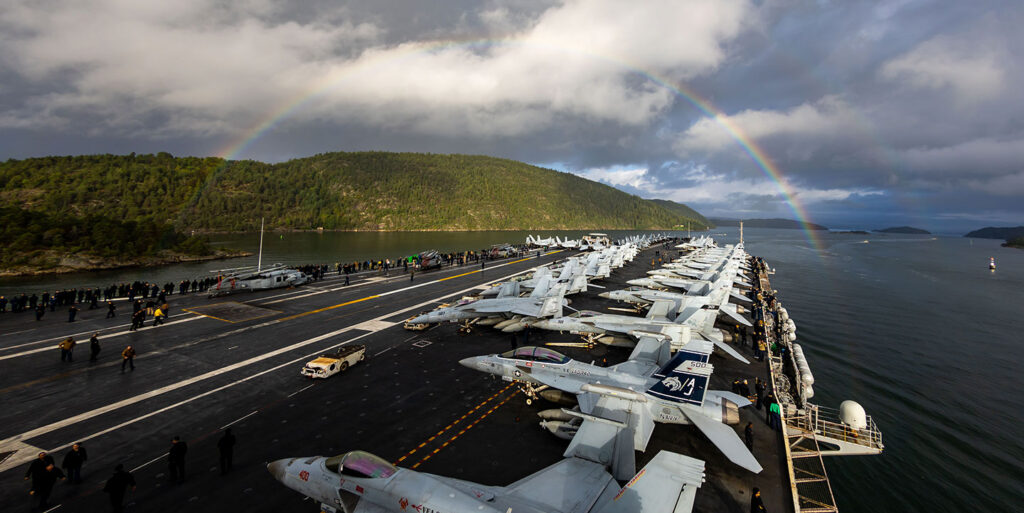The USS Gerald R. Ford, the world’s largest and most advanced aircraft carrier, sailed into Norway’s Oslofjord on September 28, 2025, in a rare show of force by the United States and NATO during the alliance’s Neptune Strike 25-3 exercise. The visit came amid unexplained drone sightings near NATO military installations and airspace violations by Russian military planes in several alliance countries. “That’s something you don’t see every day! The world’s largest aircraft carrier, USS Gerald R. Ford, sailing in the Oslofjord,” NATO posted on the X social media platform September 28.
Carrying over 75 combat-ready aircraft, the Ford is equipped with electromagnetic launch systems, dual-band radar and a wide, integrated array of the most advanced defensive technology ever deployed. The aircraft carrier, based in Norfolk, Virginia, was the centerpiece of Neptune Strike 25-3, which included 10,000 service members from 13 allied nations.
The carrier is designed to launch aircraft at a rate of at least four planes per minute in optimal conditions using the electromagnetic launch systems. That means the flight deck crew can launch two aircraft and land one every 37 seconds, the Navy says.
Seeing a U.S. aircraft carrier cruising the narrow waters of an icy fjord with its full strike group sends a message to Russia and all other adversaries about the United States’ unwavering commitment to readiness, collaboration and allied security as Europe is tested amid war in Ukraine. During Neptune Strike, the Ford Carrier Strike Group operated under direct NATO command in the North Sea.
Fighter jets from the Ford flew exercise bombing missions from the North Sea as far north as Finland as part of Neptune Strike. “We can fly the F-18s 1,000 miles (1,600 kilometers), and even longer with aerial refueling. No problem to reach Finland,” Capt. David J. Dartez, commander of Air Wing 8 (CVW-8), told the Barents Observer, a Norwegian online newspaper. CVW-8, based at Oceana Naval Air Station in Virginia, is attached to the Ford.
Dartez told the Barents Observer that Russian aircraft approached the carrier when it traveled to northern Norway in the Norwegian and Barents Seas. “Norway’s F-35 did a fantastic job. They were called to intercept that maritime aircraft right away and there was a very successful handoff by the Norwegian F-35s to our F-18s when the maritime aircraft came and flew around the strike group,” Dartez said. “We had custody of them the entire time. They did not get within any range without us on the wing.”
Capt. David W. Skarosi, the Ford’s commanding officer, said his crew learned a lot about Arctic operations in the region’s challenging conditions. “We did multiple recoveries in very limited visibility, as the weather could change rapidly. The professionals on the flight deck and our carrier air traffic controller did a super job handling that challenge,” Skarosi told the Barents Observer.
“Norway and Finland are the experts,” Skarosi said. “We learned from them every single day, leveraging their experience and understanding how to operate up there seamlessly is vital to our execution and the endurance of our alliance.”
As Russia ramped up its provocative incursions, NATO nations invoked Article 4, a call for urgent consultations, twice in September. The first time was on September 10, after Russian drones entered Polish airspace. The second was on September 19, after three Russian MiG-31 fighter jets violated Estonian airspace for nearly 12 minutes.
“Russia bears full responsibility for these actions, which are escalatory, risk miscalculation and endanger lives. They must stop,” the North Atlantic Council said in a statement afterward. NATO noted that airspace violations also had occurred in Finland, Latvia, Lithuania, Norway and Romania.
Authorities in Denmark also confirmed multiple drone incursions over sensitive military areas and civilian airports, attributing them to a “professional actor.” A new Danish intelligence threat assessment released October 3 concluded that Russia is in an increasingly intense “hybrid war” with NATO, The War Zone defense news website reported.
“It is highly likely that the hybrid threat from Russia against NATO will increase in the coming years,” the report said. “The threat of sabotage against the Danish Armed Forces is HIGH.”
NATO’s response to the airspace violations was resolute. “Russia should be in no doubt: NATO and allies will employ, in accordance with international law, all necessary military and non-military tools to defend ourselves and deter all threats from all directions.”
Several European countries warned Moscow that they are ready to shoot down Russian military aircraft the next time there is a severe airspace violation. U.S. President Donald Trump also said September 23 that he would back NATO countries that choose to shoot down intruding Russian planes.
Neptune Strike “is designed to demonstrate NATO’s ability to integrate high-end maritime strike capabilities, strengthen deterrence, and ensure freedom of navigation across critical waterways,” NATO says. “It also aims to secure strategic maritime chokepoints while testing interoperability across air, land and sea.” Neptune Strike 25-3, the third iteration of the 2025 exercise, spanned the Adriatic, Baltic, Mediterranean and North Seas.

